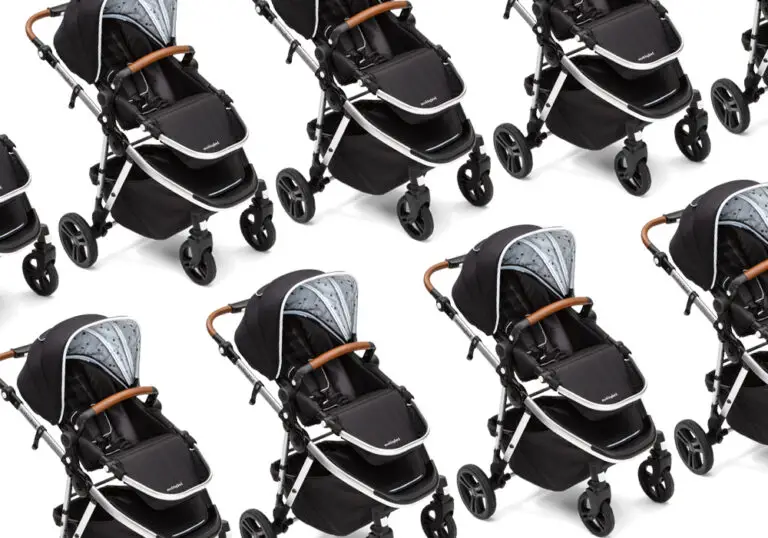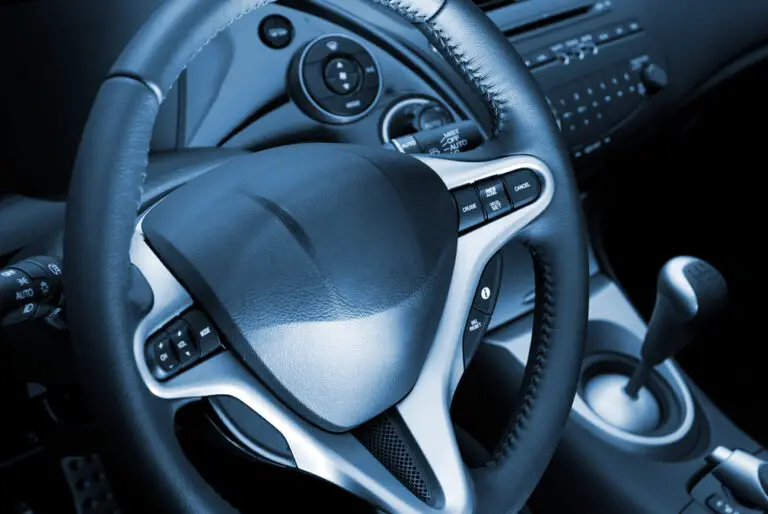Ohio Car Seat Laws 2024 (Rear, Forward & Booster)

Ohio car seat laws require children younger than 4 years old and less than 40 pounds to be secured in a child restraint. Those less than 8 years old and shorter than 4’9” have to ride in booster seats.
The penalty for not using a child restraint is $155, while that for a booster seat is $88 plus a $115 bond.
Disclaimer: This content does not constitute legal advice. It is solely for informational purposes. Always check the original source of the law for the latest version.
- Rear-Facing
- Forward-Facing
- Booster
- Front Seat
- Seat Belt
- Taxi Seat
- Ridesharing Seat
- Replacement
- Alone in Car
- Choosing a Seat
- Installation Help
Ohio Car Seat Laws
Ohio Rear-Facing Car Seat Law
There is no specific rear-facing car seat law in Ohio. A child under 4 years of age and/or weighing less than 40 pounds has to be secured in a child restraint system that meets federal motor safety standards. (1)
Without a clear Ohio rear-facing child seat law, it is best to follow the guidelines of the American Academy of Pediatrics (AAP). As per these, an infant must be placed in a rear-facing car seat.
The rear-facing car seat age in Ohio is absent. But the AAP recommends that children ride rear-facing for at least till the age of 2 years.
This does not apply if the child, in the opinion of a licensed physician or chiropractor, cannot use a child restraint due to a physical impairment.
Violating these Ohio car seat regulations carries a penalty of $155 and a mandatory court appearance.
Age: Less than 4 years
Weight: Less than 40 pounds
Penalty: $155 plus mandatory court appearance.
Ohio Forward-Facing Car Seat Law
There is no express forward-facing car seat law in Ohio. However, the National Highway Traffic Safety Administration (NHTSA) recommends that children must ride forward-facing after they have outgrown the height or weight limits of their rear-facing seats.
Under Ohio child seat laws, children younger than 4 years and/or weighing less than 40 pounds must be placed in a child restraint that meets federal safety standards unless they are exempt. (1) For young children aged 2 to 4 years, this means a forward-facing car seat with a harness and tether.
A legally mandated forward-facing car seat age in Ohio is absent. In the absence of an Ohio forward-facing child seat law, it is best if children ride forward-facing till they reach the maximum limits prescribed by the seat manufacturer. The penalty for violating the regulations is $155.
Age: Less than 4 years
Weight: Less than 40 pounds
Penalty: $155
Ohio Booster Seat Law
According to the child booster seat law in Ohio, children less than 8 years old and shorter than 4’9” who have outgrown their forward-facing seats must ride in booster seats. (1) It can be a high-back or backless booster seat.
The booster seat age in Ohio is 4 to 8 years. However, children should continue riding them till they reach the prescribed maximum height or weight specifications or are big enough to fit into a lap and shoulder belt.
A child who cannot use a child restraint due to medical or physical reasons is exempt from child seat requirements in Ohio. They must have an affidavit signed by a licensed physician or chiropractor stating the same.
The penalty for violating Ohio booster seat requirements is $88 and a bond for $115.
Age: 4 to 8 years
Height: Shorter than 4’9”
Penalty: $88 plus a bond for $115.
Ohio Child Front Seat Law
The child front seat law in Ohio is absent. The backseat is the safest position for children.
This is reiterated by the AAP, which recommends they should ride in the backseat till they are 13 years old. So even though the front seat age in Ohio is unclear, it is best to follow AAP recommendations.
If it is absolutely necessary, a child can ride in the front seat in a car seat that is appropriate for their height and weight.
The vehicle seat must be pushed as far back from the airbag as possible. If you are traveling with a child in a rear-facing seat, the front seat passenger-side airbag must be deactivated.
You must follow these requirements to ensure the complete safety of your child in the front seat.
Age: 13+ years (recommended)
Ohio Child Seat Belt Law
According to the child seat belt law in Ohio, children between 8 to 15 years old and taller than 4’9” must wear an adult safety belt while traveling in a vehicle. (1)
This applies regardless of whether they are in the backseat or the front seat. The seat belt must be properly adjusted and fastened.
Seat belt rules in Ohio do not apply when a child is being transported in an emergency situation that threatens their life.
Additionally, those children who cannot wear a seatbelt due to a physical or medical condition are also exempt from these requirements.
They must carry a signed affidavit from a licensed physician or chiropractor to that effect. Not wearing a seat belt under Ohio children’s seat belt law carries a penalty of $88 and a bond of $115.
Age: 8 to 15 years
Height: 4’9” or taller
Penalty: $88 plus a bond for $115.
Ohio Taxi Child Seat Law
According to the taxi child seat law in Ohio, taxis are not required to have a child passenger safety system in place. Car seat laws in Ohio apply when a child is being transported in a vehicle “other than a taxicab.” (1)
The taxi driver is not responsible for providing a taxi child seat in Ohio. But as parents and caregivers, it is best if you arrange an appropriate car seat before traveling with your child in a taxi.
Depending on the child’s age, you can select a rear-facing, forward-facing, or booster car seat. These car seats will provide adequate protection for your child.
When installing the car seat in a taxi, it is your responsibility to ensure that it is securely fixed. You can also ask the driver to help with the installation.
Ohio Ridesharing Child Seat Law
The ridesharing child seat law in Ohio is unclear.
Ohio state law requires all children younger than 4 years and/or weighing less than 40 pounds to be placed in an appropriate car seat. Those under 8 years old and shorter than 4’9” have to ride in a booster seat. (1)
The motor vehicle operator has to ensure that the child is properly secured. But the law does not mention ridesharing services such as Uber or Lyft.
The best option, in this case, is for either the driver or the parents/caregivers to provide a child seat. For infants under the age of 2 years, this means a rear-facing car seat.
Those who have outgrown these should be secured in a forward-facing seat. Young children shorter than 4’9” should use a booster seat.
Ohio Child Seat Replacement Law
There is no definite child seat replacement law in Ohio. However, a car seat should be replaced after it is involved in an accident or has expired.
The NHTSA recommends child seat replacement after an accident, especially after a moderate or severe crash. In case of a low-impact accident, there is no urgent need to replace the child safety seat.
A low-impact crash is where no passenger is injured, the door nearest to the car seat is not damaged and the seat itself shows no visible damage.
Apart from replacing the seat after an accident in Ohio, you must also replace it after it has expired. It must not be used beyond the period stated by the manufacturer. If the seat has been recalled, you should replace it immediately.
Leaving Child in The Car in Ohio
There is no provision in the law on leaving a child in a vehicle in Ohio. However, leaving a child unattended in a vehicle is extremely dangerous. The most common danger is heat stroke.
The temperature inside the vehicle can rise rapidly. Since children’s bodies heat up faster than adults, they are at great risk of suffering a heat stroke.
There are other dangers too. The child can get kidnapped, set the car in motion, get strangled by seat belts or power windows or have some other in-car accident.
Even though leaving a child in the car in Ohio is not technically illegal, it may be covered under stricter sections such as child endangerment. Thus, never leave a child alone in a vehicle, even for a few minutes.
Choosing a Child Car Seat in Ohio
Child passenger safety seats in Ohio must be used as per the manufacturer’s instructions.
Therefore, when you are choosing a car seat in Ohio, you must ensure that it is appropriate for your child as per the criteria listed by the manufacturer. The NHTSA recommendations can help.
From the time your child is born till they turn at least 2 years old, a rear-facing car seat is the best car seat to use in Ohio.
They can then move to a forward-facing seat. After they outgrow these, they should use booster seats. A high back or backless seat is the best booster seat to use in Ohio.
Car Seat Installation Help in Ohio
Car seats work well only if they are installed correctly. Many find the installation process to be complicated. As a result, a large number of car seats are incorrectly fitted.
To help you with car seat installation, Ohio has different stations with certified Child Passenger Safety (CPS) technicians.
You can get your car seat checked or installed and also learn more about child passenger safety. Some of the stations where you can get assistance with car seat installation are:
- City of Columbus
- Whitehouse Police and Fire Departments
- Washington Township, Dublin
- Truro Township Fire Department
- Marysville Division of Police
- Elyria Fire Department
Ohio Car Seat Safety Resources
- Ohio Department of Health: Violence and Injury Prevention Program
- Cleveland Clinic: One of the leading hospitals in the country, it provides safety tips to parents on the different types of car seats and how to use them correctly.
- Nationwide Children’s Hospital: It has information about the law as well as general car seat safety tips for child passengers.
- Injury Biomechanics Research Center: The center conducts research geared towards preventing injury in children. The results of the studies are used to develop commercial products and education programs.
- Cincinnati Children’s Hospital: The website has a comprehensive list of resources for child passenger safety. They include types of car seats, fitting stations, legal information, and safety videos.
FAQ
How long should a child ride in a rear-facing car seat in Ohio?
The law does not expressly state an age. But it is recommended that a child ride in a rear-facing car seat till the age of 2 years.
Can you put a rear-facing car seat in the front seat in Ohio?
The law is silent on this. However, it is best to put a rear-facing car seat in the back. If you do put it in front, the front seat airbag must be deactivated.
Can you put a rear-facing car seat in the middle rear seat in Ohio?
You can put a rear-facing car seat in the middle rear seat, but it must fit properly. Check the car seat as well as your vehicle’s manuals.
When can a baby face forward in a car seat in Ohio?
There is no specific requirement. But a child can face forward after they have outgrown their rear-facing seat. This typically happens around 2 years of age.
How old for a booster seat in Ohio?
Children between the ages of 4 to 8 years who are shorter than 4’9” should ride in a booster seat once they outgrow their forward-facing seat according to its manufacturing limits.
When to use a backless booster seat in Ohio?
You can use a backless booster seat if your vehicle seat has a headrest and the child’s ears are not higher than the seat back.
When can a child sit in the front seat with a booster in Ohio?
Children should ideally ride in the backseat. But if it is unavoidable, they can ride in the front seat with a booster only if the front airbag is deactivated and the vehicle seat is pushed back.
When can a child stop using a booster seat in Ohio?
A child can stop using a booster seat when they turn 8 years old or reach 4’9” in height, whichever occurs first. They can then start using the seatbelt.
When can a child sit in the front seat in Ohio?
Children are safer in the backseat of the vehicle. But they can sit in the front seat with its airbag deactivated if it is absolutely necessary.
When to switch from 5 point harness to a seat belt in Ohio?
When the child outgrows the height and weight limits of the 5-point harness, they can switch to wearing a seat belt in a booster seat.
When can a child use a regular seat belt in Ohio?
Under the law, a child can start using a regular seat belt once they are 8 years old or stand at least 4’9” tall.
Do you need a car seat in a taxi in Ohio?
Taxis are not required to have a car seat. However, it is recommended that you carry an appropriate car seat for maximum protection for your child.
Do you need a car seat in a Uber in Ohio?
The law is unclear about whether it applies to Uber in Ohio. But either the caregiver or the driver should provide a federally approved and appropriate car seat.
Do you need a car seat in a Lyft in Ohio?
The law is not clear on this issue. But either the caregiver or the driver should provide an appropriate car seat to ensure the child’s safety.

Rishima Rawat
Rishima Rawat is a lawyer and legal writer with over six years of writing and legal experience. She earned her LLB degree from the West Bengal National University of Juridical Sciences, Kolkata. With a passion for child safety, she’s written extensively about the U.S. car seat laws in ParentingMode. She collaborates with businesses and law firms globally, enhancing their online content. Her insights are also published in legal journals like RGNUL, NLIU, and RMLNLU Law Review. Committed to the cause of education, she has volunteered with IDIA, which helps underprivileged children in India to access legal education. She has also worked with Enhelion Knowledge Ventures, a leading legal ed-tech platform in India that provides students with affordable courses in law. Fluent in English and Hindi with elementary proficiency in Spanish, Rishima combines her legal expertise with a dedication to child safety.






